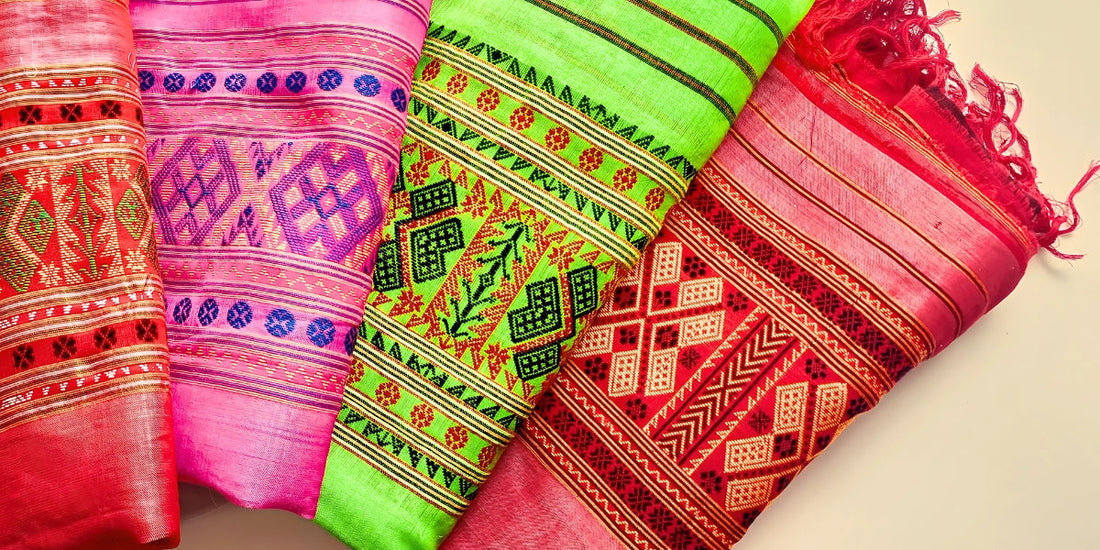
Beyond Fabric: The Timeless Beauty of Mising Mekhela Sadar
Share
In a world where modernity often takes center stage, the traditions of indigenous communities, including their unique attire, hold profound historical and cultural significance. Among these, the Mising mekhela sadar stands out as a graceful and culturally significant garment, epitomizing the rich heritage of the Mising community of Assam. This traditional attire is more than just a piece of clothing; it is an artistic expression, a cultural statement, and a symbol of identity for the Mising people. Let us explore the origins, significance, and craftsmanship behind this exquisite piece of cultural heritage.
________________________________________
Who are the Mising People?
The Mising community, also known as the "Miri," is one of the prominent indigenous communities of Assam. They primarily reside along the banks of the Brahmaputra River and its tributaries, with a deep-rooted connection to nature and a lifestyle centered around agriculture. Over centuries, the Mising people have preserved their unique culture, language, and traditions, which are vividly reflected in their lifestyle and attire.
________________________________________
What is a Mising Mekhela Sadar?
The mekhela sadar is a two-piece traditional attire worn by Mising women. It consists of:
- Mekhela: A cylindrical piece of cloth draped around the lower body like a skirt.
- Sadar: A long, rectangular piece of fabric draped around the upper body, often tucked into the mekhela.
The Mising mekhela sadar is distinct for its vibrant colors, intricate patterns, and the use of natural fibers, often handwoven on traditional looms. The attire combines simplicity with elegance, making it suitable for both daily wear and festive occasions.
________________________________________
Symbolism and Cultural Significance
The Mising mekhela sadar is more than just a garment; it carries profound cultural and social significance:
- Identity: It represents the Mising community's pride and serves as a marker of their distinct heritage.
- Tradition: The motifs and patterns on the fabric often draw inspiration from nature, mythology, and Mising folklore, reflecting their worldview and beliefs.
- Occasions: The mekhela sadar is an integral part of celebrations, festivals, and ceremonies like "Ali-Aye-Ligang," a festival that celebrates agriculture and the sowing of seeds.
- Empowerment: The weaving of mekhela sadar is traditionally a women-led craft, providing economic empowerment and preserving indigenous knowledge.
________________________________________
Craftsmanship: The Art of Weaving
The making of a Mising mekhela sadar is a labor-intensive process, showcasing the skill and artistry of Mising women. Here’s a glimpse into the process:
- Looms and Materials: The Misings primarily use traditional handlooms (Mati Xaal) to weave the fabric, with cotton and eri silk being the most common materials.
- Natural Dyes: Traditionally, the colors are derived from natural sources such as plants, roots, and flowers, giving the fabric its earthy and vibrant tones.
- Motifs and Patterns: Common designs include geometric shapes, floral patterns, and motifs inspired by the riverine and agricultural lifestyle of the community.
- Time and Precision: Depending on the intricacy, it can take weeks or even months to complete a single mekhela sadar, making each piece a work of art.
________________________________________
Modern Adaptations and Global Recognition
In recent years, the Mising mekhela sadar has gained recognition beyond the borders of Assam, thanks to efforts by fashion designers, cultural enthusiasts, and NGOs. Modern adaptations of the attire, blending traditional patterns with contemporary styles, have found their way into global fashion circuits. These initiatives not only promote the rich heritage of the Misings but also provide a sustainable livelihood to the weavers.
________________________________________
Challenges and the Way Forward
Despite its beauty and significance, the tradition of weaving mekhela sadar faces challenges such as:
- Declining Interest: Younger generations are gradually moving away from traditional crafts due to urbanization and modern lifestyle choices.
- Competition: The influx of cheaper machine-made fabrics poses a threat to hand woven textile.
- Lack of Support: Insufficient government and institutional support often hampers the growth of traditional weaving industries.
To address these challenges, it is essential to:
- Promote the mekhela sadar through cultural events, exhibitions, and online platforms.
- Provide training and financial support to weavers.
- Encourage the younger generation to embrace their cultural roots.
- Collaborate with designers and brands to create demand for Mising textiles in global markets.
________________________________________
Conclusion
The Mising mekhela sadar is a testament to the rich cultural heritage and artistic brilliance of the Mising community. It embodies their connection to nature, their resilience, and their artistic ingenuity. As we celebrate this exquisite attire, let us also pledge to support the artisans who keep this tradition alive and ensure that the legacy of the Mising mekhela sadar continues to thrive for generations to come.

